Prologue
My best friend decided she was going to get a snake plant, her very first plant, during this April Quarantine. She’s never gotten one in the past because her work schedule is demanding (back when she’d commute into the city.) Needless to say, the last thing she wanted to do when getting home late is take care of another “chore”. Now being stuck inside, she’s changed her mind about plant parenthood. So I talked her through the basic steps of where to purchase it online, how to get it acclimated, etc. She couldn’t believe how little she needed to do and how easy it was in terms of caring for her new plant, once she had the guidance to get started. One week later, she’s completely obsessed and getting more plants as we speak. We talk constantly about plants now & she said this (post) was something that needed to be shared, how to simply get started with plants the right way. It completely changed her mind about plants and nurtured her desire to have more beneficial additions to the home.
So here we are – I hope you enjoy!
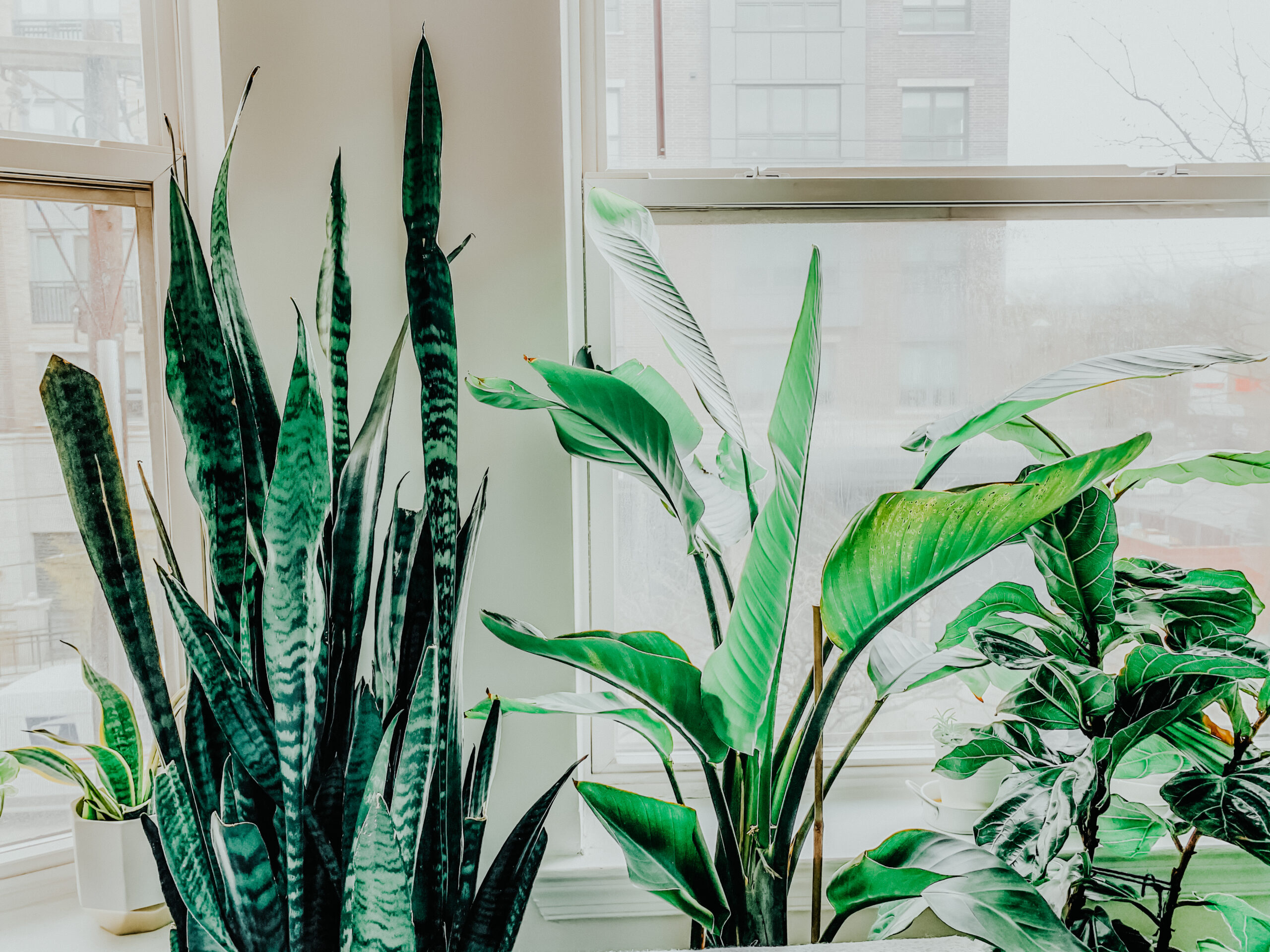 [L-R] ‘Futura Robusta’ Snake Plant, Bird of Paradise, Fiddle Leaf Fig
[L-R] ‘Futura Robusta’ Snake Plant, Bird of Paradise, Fiddle Leaf Fig
WHY PLANTS? THE OBSESSION BEHIND THEM
Quarantine or not, having plants in the home is more than simply filling an empty space with decorative greenery. For starters, they’re extremely beneficial when it comes to the simple act of breathing – something we’re not taking for granted even more these days. Plants absorb carbon dioxide & release oxygen from their leaves, which humans & animals clearly rely on. Many plants also work towards purifying the air, which might be the best thing to happen to small spaces / tiny apartments. Needless to say, they’re constantly adding value towards the quality of (indoor) living.
Despite what many people think, and therefore use as an excuse not to do the whole plant thing, they’re one of most low-maintenance living things to care for. Take it from me – I own 40 plants (yes that many..) and I care for all of them only ONCE a week with watering. I kid you not. My single cat far surpasses the amount of demand these 40 plants ask of me. The trick is to get into a routine, which we’ll discuss a later in this post. But I promise you, the level of minimum care you need to keep your plants alive is probably the reason people get obsessed & end up getting more. That plus the fact we’re approaching two months of not leaving our homes.
WHICH PLANT IS RIGHT FOR YOU?
So you’ve been persuaded or inspired to trying plant parenthood out for yourself, either by reading those three above paragraphs or simply finding inspo on your own. Either way, YAY! I’m so glad you’re here. I promise you won’t regret any of it if your passion ignites through this journey.
Before anything, the first thing you want to do is ask yourself a few questions that will determine which plant species is the best fit, similar to adopting a pet. You don’t want to just get something without doing any research on whether or not it’ll do well in your home. In fact, you could say that the people claiming they “kill every plant they touch” probably are the ones impulse buying. No wonder they didn’t want to continue with getting more plants…
At the end of the day, we’re all going to accidentally kill a plant or 20 in our lifetimes – it’s ok. You learn as you grow them. But having an idea of what plants will work well in your home builds the foundation of your success – start strong!
—
1. How much natural light does your home get? How many windows? Do you turn on the lights during the day or can get away with leaving them off until evening?
You want to determine the amount of light your home gets naturally, as this will greatly affect the type of plant that will thrive in your environment. Plants’ light dependency range from high-medium-low: High = most light, Medium = average light, and *Low = little light. *Keep in mind, just because its a low light plant doesn’t mean it can live in the dark. Like humans, all plants are dependent on sunshine and need it in order to stay well; they just don’t need as much of it as others do. In general, you should always plan to display your plants near a source of light, whether it be naturally by a window or artificially by a grow light.
If you’re unsure how much light a corner of your apartment/area of your home near a window receives, you can use the free Lux Light Meter Pro app to measure its intensity. This app is made for measuring light for cameras, but it works just the same for the purposes of plant light.
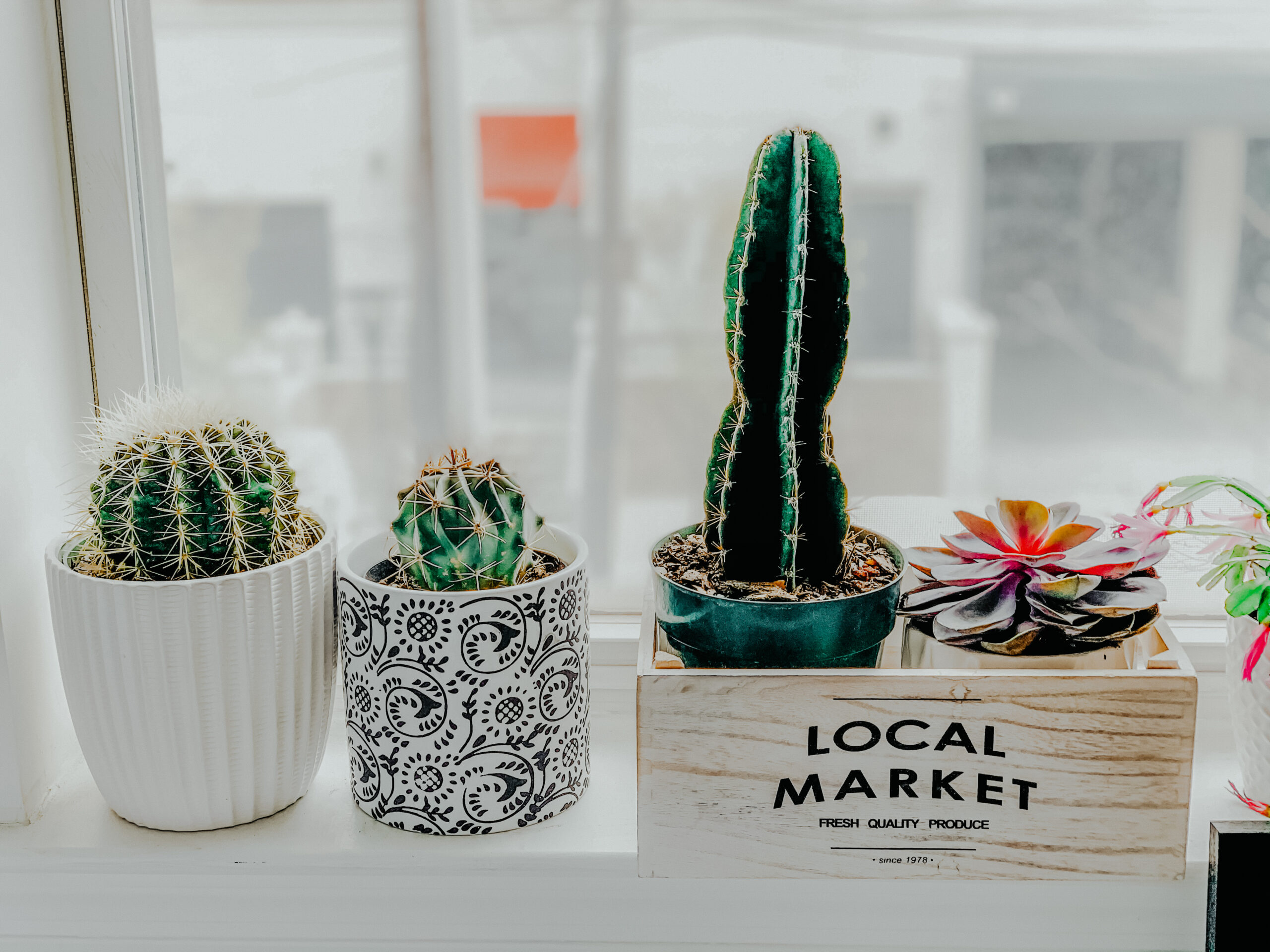 [L-R] Golden Barrel Cactus, Carmine Cob Cactus, Column Cactus, Echeveria ‘Perle von Nürnberg’ Succulent
[L-R] Golden Barrel Cactus, Carmine Cob Cactus, Column Cactus, Echeveria ‘Perle von Nürnberg’ Succulent
2. How much do you travel? Are you on the road/flying two or more times a month?
This COVID-19 moment won’t last forever, so it’s important you determine your willingness to maintain them post-quarantine. Although I mentioned before that plant care is very VERY undemanding, you still need to water them 1x a week. If you live alone & away for 1-2 weeks at a time, you probably don’t want to get anything other than a cactus or something in the succulent family. Those varieties ask for water only 1-2x a month, not on a weekly basis. Those are the ones that thrive on ‘neglect’ which I hate to admit but are more likely to survive for when you’re gone.
If your travel plans are more sporadic on a 3-5 day basis occasionally, that’s ok too. You don’t have to stick to just a cactus or succulent. My suggestion is to get a plant that’s older, more mature (nothing smaller than something in a 6″ pot – we’ll discuss that later.) Older plants are hardy, more robust and can bounce back quicker than younger ones if you forget to water them after a few days.
—
3. Do you have a pet &/or small children in your home?
Lastly, you want to determine what kind of household you’re bringing your plant back to – one with pets, small children, or both? Either way, you want to ensure the plants you bring home are those that are labeled “pet-friendly” – aka NOT TOXIC. If it’s safe for a curious pet to chew on, then it’s safe for a curious child to potentially ingest too. Even if you think your pet/child is too mellow for such behavior, you never really know what happens when you turn your back for a moment.
For example, my cat is only interested in chewing on plants that look like grass, like my alive Pony Tail Palm or any of the artificial ones I still have around. Although he won’t get sick if he chews on the real one, I’ve made sure to put it (and the fake ones) out of accessible reach for him to get to. I don’t know how I’ve managed to cat-proof the location of this plant, but I’ve been successful for several months now (knock on wood.) My suggestion is put any sort of plant you worry about in a higher location & out of reach from small hands, rambunctious pups, or curious kitties if you can.
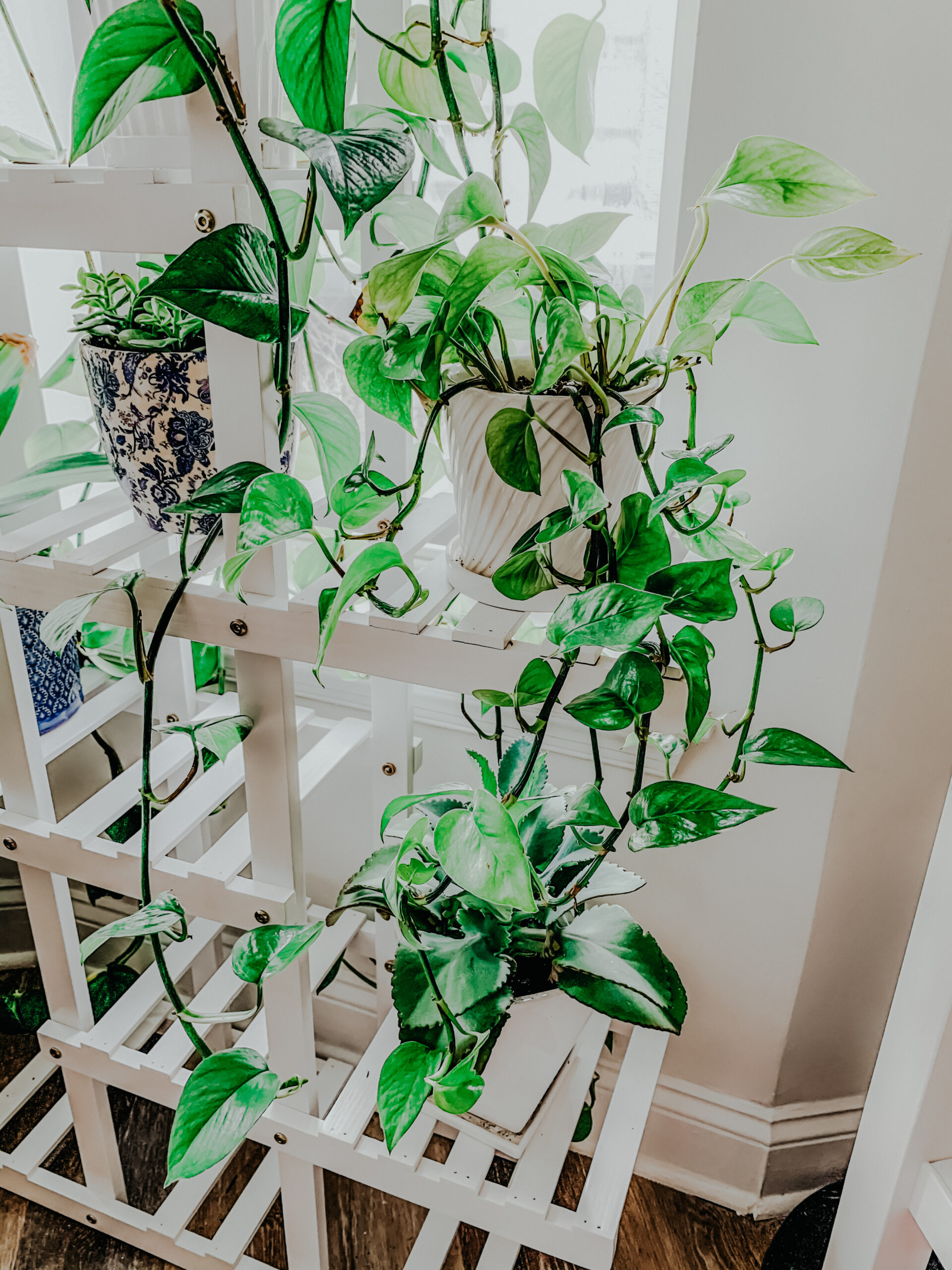 [clockwise] Jade Plant, ‘Golden’ Pothos, ‘Mother of Millions’ Kalanchoe
[clockwise] Jade Plant, ‘Golden’ Pothos, ‘Mother of Millions’ Kalanchoe
BEST ONLINE STORES TO PURCHASE PLANTS FROM
As much as I’d rather shop locally at a nursery or garden center for my plants, I don’t have that option much these days. Some stores are still open and selling plants, but going out for such a purchase isn’t something I want to do at a time like this. It’s always more satisfying to see the health of the plant in-person before purchasing and the instant gratification is no doubt the best, but there are plenty of local, small business plant stores online that are fantastic places to buy from. You have to wait 1-2 days but luckily, plant purchases ship quicker as it’s labeled “LIVE.” The urgency to deliver it takes priority, I’ve noticed. Here are some online plant retailers that I’ve purchased from, all of which provided me with healthy & happy plants upon delivery and throughout my ownership:
—
Hey Horti
They offer a subscription packages of monthly deliveries & have a variety of rare plants that I’ve never been able to find in any garden centers or nurseries (Brooklyn-based)
The Sill
Big fan of this online small business. I’ve purchased many of my plants from here & reference their blog/workshops as often as I can (more on that later in this post.)
Plant Shed
If you’re lucky to visit one of their NYC locations in person, prepare to be in awe! Gorgeous varieties available
Terrain
Anthropologie’s sister plant, home & garden store! I’ve gotten many unique finds & cute planters from here
Bloomscape
They specialize in grown plants that arrive already potted in a beautiful planter (that you choose.) I’ve gotten my two largest plants from them.
Urban Stems
Offers a variety of plants to choose from in the coolest pots I’ve seen yet. Fast delivery too (depending on location.)
Costa Farms
Yes you can buy plants on Amazon & I recommend shopping from this credible plant retailer.
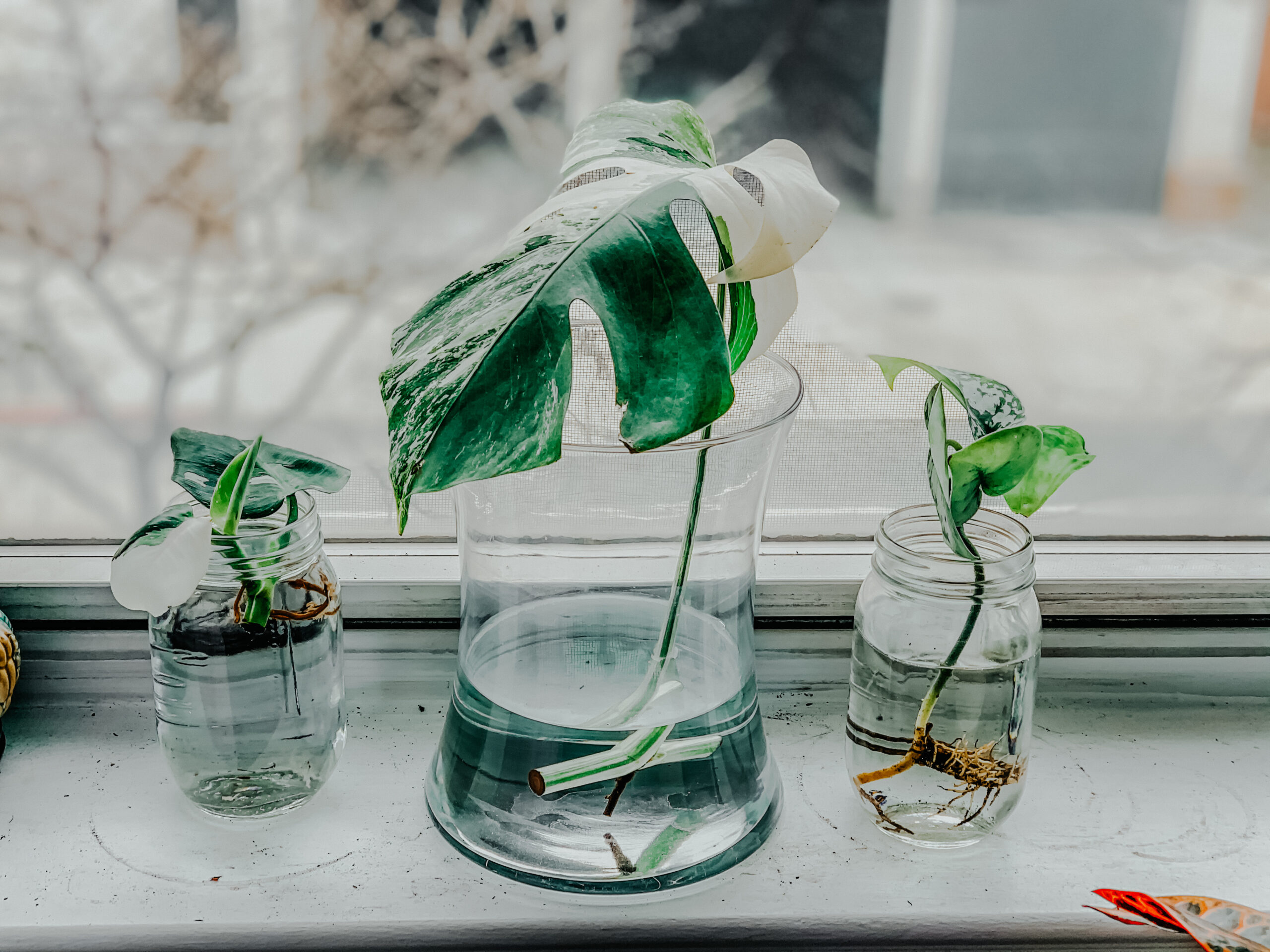 [Cuttings L-R] ‘White Wizard’ Philodendon, Variegated ‘Albo’ Monstera Deliciosa, ‘Satin’ Pothos
[Cuttings L-R] ‘White Wizard’ Philodendon, Variegated ‘Albo’ Monstera Deliciosa, ‘Satin’ Pothos
ETSY SHOPS
—
American Plants – I got the most BEAUTIFUL plant from here; tons to choose from
The Plant Chica – the source for all your wishlist plants
Plant Crafting Co – family-run nursery, beautiful plant listings added daily
Kels Succulent Shop – an online shop for succulent lovers
Kauai Garden – unique assortment of plants, cactus species, & succulents
My Green Gallery – beautiful assortment of young 4″ plants
Jaqueline Home Garden – offering a variety of 4″ plants
Sunshine & Vines – sells uncommon to rare plants
Variegata777 – specializes in rare variegated cuttings
HOW TO KEEP THEM ALIVE & WELL
Here’s the part of this blog post you want to pay the most attention to once you’ve made your plant purchase. I know plants are easy but they do ask of a few things that will set the pace of whether or not they’ll do well once in your care. Don’t worry, these are simple requests that aren’t mandatory by any means, but I will say I’ve noticed all of my plants are constantly thriving as a result of these suggestions below. So here are some of my tips & tricks for keeping your plants alive, and rewarding you with continuous growth as a result:
—
Pick the right size pot
You want to replace the plastic grower pot your plant arrives in with something ceramic, which is more long-term & stable of a home for your plant to grow going forward. The reason you want to replace the plastic grower pot is because if you look at the bottom of it, it’s full of holes and most likely has roots starting to poke through them. It doesn’t allow for the plant to receive proper drainage from watering and inhibits the roots from receiving adequate soil in order to grow.
I can’t tell you how many times I’ve made the mistake of assuming a ceramic pot will fit a specific size plant, only to realize it was too small. So it’s important to make sure you’re buying the right size pot based on the measurements of your plant when you purchase it – you can locate those details normally on the plant itself when buying in person; size can be found online under the details or even the title of the plant listing. If it’s not mentioned, be sure to message the shop owner to ask before buying.
Here’s the thing I’ve discovered: if you buy a plant in a 4″ plastic pot, that doesn’t mean you should get 4″ ceramic pot for it. You should actually get a ceramic pot that’s 1-2 inches larger than the plant itself; so in this case, aim for one that’s 5-6″. Having a pot a little bit larger than the plant’s width allows for room to grow, as well as gives you the ability to position it without force. The slight bit of room also helps set the plant up to acclimate well to the surrounding soil you’ll be adding to it, while keeping it intact in the soil it’s currently in & used to from the plastic pot.
—
Replant using organic soil
As mentioned above, you want to surround your new plant with fresh soil once transferring it to the new pot. Soil is the plant’s source of nutrients for growth, like food is fuel for humans. Why organic? Because like organic food, it’s sourced better and healthier for the plant to consume from the roots, which is reflective of its shoots (stems/leaves) above soil. If you have the option to pick between food loaded with chemical enhancements or food with all natural ingredients, which would you prefer to consume? Rhetorical question, but the point is why wouldn’t you do the same for your plant?
There are a lot of soils out there, but the brand I’ve been using and that all my plants have acclimated well to is the Espoma Organic Potting Mix. I like that it comes in smaller-sized bags, which makes it easier to store/hide out of sight in an apartment. *For cactus and succulent plants, they require a different type of soil nutrient blend based on their natural environment. Espoma carries an Organic Cactus Mix that does well for all my cacti & succulents so far as well.
…
Tip: When repotting a plant, place a thin layer of soil on the bottom of the ceramic pot and then sprinkle some tiny pebbles/rocks in the center before placing the plant inside and surrounding it with more soil. The rocks help with drainage when you water, which is helpful for keeping the plant out of sitting in wet soil. Think of how you feel standing in wet shoes; that’s how the plant feels when the water doesn’t drain properly. Depending on the species, wet soil can show its effect on the plant by slight discoloration of the leaves or in a more drastic way like root rot, which is something you want to avoid at all costs.
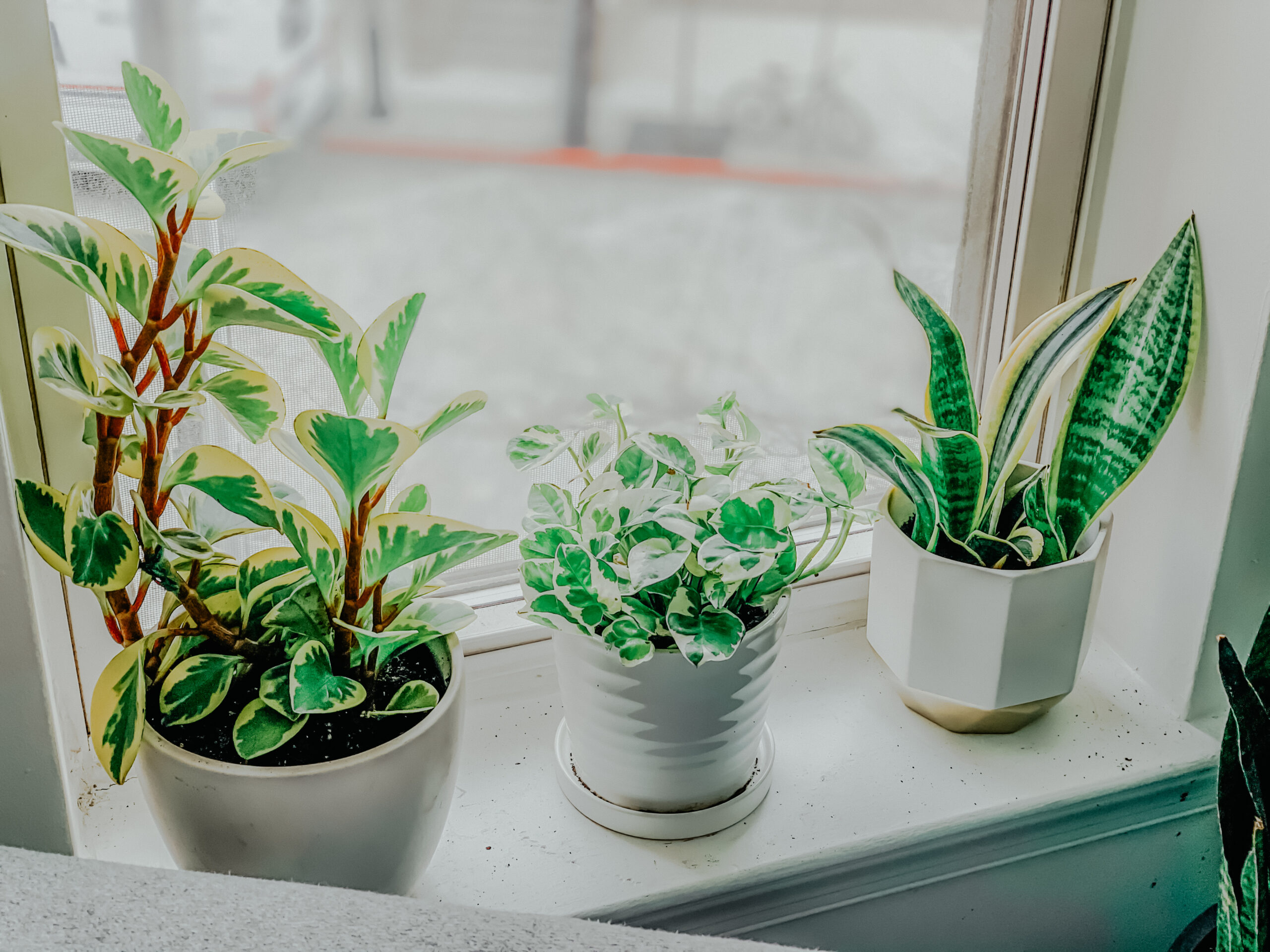 [L-R] Peperomia Marble, ‘N’Joy’ Pothos, ‘Black Gold’ Snake Plant
[L-R] Peperomia Marble, ‘N’Joy’ Pothos, ‘Black Gold’ Snake Plant
Do your research on the plant species’ needs
Whenever I get a new plant, I always do research on what it specifically needs in terms of water & light in order to thrive. Our apartment gets tons of natural, bright, indirect light from our windows with several areas nearby that provide medium-low light spots. Based on the plant I’m getting/gotten, I make sure to know exactly where I should place it in my apartment from the start.
From my experience, I’ve learned that plants that require bright, indirect light prefer bigger drinks of water than those in medium, low light positions. It makes sense if you think about it, the soil is more likely to dry out in a sunny spot quicker than a plant’s soil that’s not. Of course, all plants are different so if you’re unsure with how much water you should be giving your plant, always start off with less. If the plant starts to droop after a day or two, it most likely needs a bigger sip & will bounce back once you give it one. A good rule of thumb with watering plants is that you can always add more water, but you can’t subtract it as easily once its poured.
—
Pro Tip: Use filtered water over tap water
Sounds high maintenance but hear me out. Although tap water is safe to drink for humans (in most areas), there’s still a handful of calcium in there that isn’t the best to give a plant. In Hoboken, the tap water is undrinkable (literally) so I got in the habit naturally of watering my plants with the filtered water from the fridge built-in system. When I lived in the city, I just gave them water from the sink. Nothing happened to the plants when I gave them tap water but when I started giving them filtered, I noticed a HUGE boost in their growth as a result. My fiddle leaf fig (one of the picker species I own) grew 2 leaves in 5 months when I was in the city; since moving to Hoboken, its grown 8 in 5 months! It’s not something you need to go out of your way for but if you’re drinking from a Brita pitcher anyway, why not use it for your plants’ water as well.
MY FAVORITE PLANT CARE TOOLS + RESOURCES
TOOLS
Soil Moisture Sensor Meter – measures the amount of water in the soil. Very helpful if you’re not sure how much water to give a specific plant. Comes with a reference guide that places plant species in color zones according to the meter.
Lux Light Meter Pro – mentioned this above but helpful free app that measures the amount of light in your home. Makes determining best locations for certain plants easier.
Gardening Gloves – only recommend these if you own cacti that need repotting. Don’t attempt without protection (trust me..) I know the ones I’ve linked here are long but all the shorter glove options weren’t thick enough to block from the spikes, resulting in lots of splinters for yours truly.
Self-Watering Auto Drippers – I got these when we were in Amsterdam for 10 days & didn’t have anyone to stop by to water the plants for us. They’re very simple to set up and use, as well as effective- none of our plants died! Make sure to read the instructions on which brand of water bottle works, as there’s a specific groove for when you screw it on in replacement of the bottle cap.
Trimmers – as plants grow, older leaves die. It’s just the nature of it. But you want to trim off any dead or yellowing leaves from your otherwise healthy plant as soon as you spot them. These trimmers are great for exactly that.
Watering Can – I LOVE this particular watering can because of its thin, long nose. Helps me efficiently water the most tangled of my plants, as well as those in harder to reach places. It’s super cute to display on its own but also doesn’t take up much room to store when not in use either.
MiracleGro Shine Leaf Spray – plants absorb sunlight through their leaves, so it’s helpful to dust them off once & a while to promote better absorption and ultimate growth. This spray is water-based with mineral oil, odor-free and won’t clog leaf pores. It leaves them looking so glossy afterwards they almost look fake! Big fan of this.
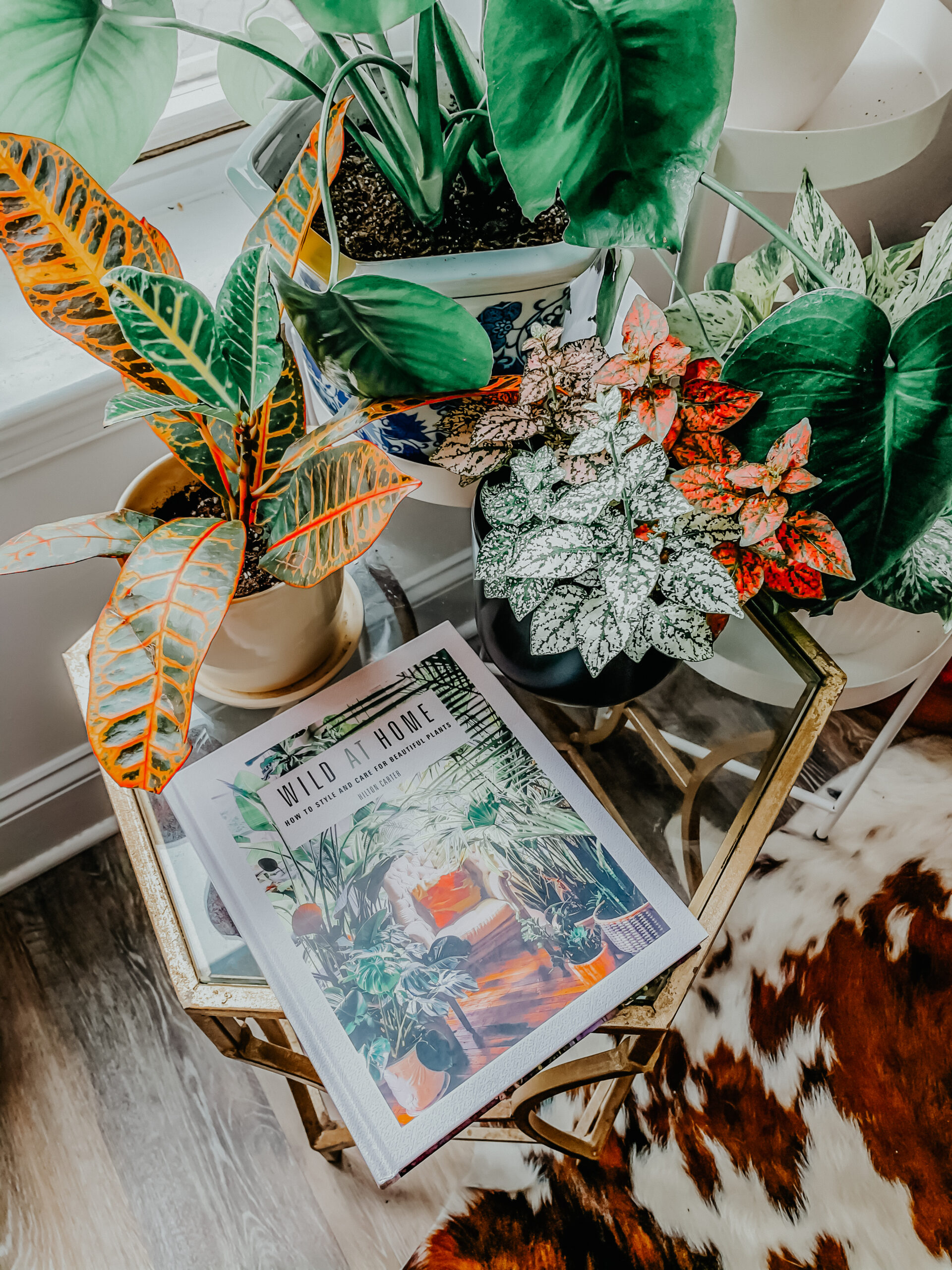 [L-R] ‘Petra’ Croton Plant, Monstera Deliciosa, ‘Confetti’ Polka Dot Plant, ‘Marble Queen’ Pothos
[L-R] ‘Petra’ Croton Plant, Monstera Deliciosa, ‘Confetti’ Polka Dot Plant, ‘Marble Queen’ Pothos
RESOURCES
The Sill OnlineWorkshops – these workshops are usually hosted in the shop locations but The Sill has adapted to these Quarantimes well by making them virtual! This is great actually because the workshops are usually sold out due to limited space; with it being virtual, that means more people can join in on this super informative workshop presentation. I learned A LOT from the Plants 101 workshop and was able to ask the Plant Expert hosting the Zoom workshop specific questions regarding my personal plants. Highly recommend signing up for one if you’re brand new to the world of plants or even if you want to expand on your existing plant knowledge.
Bloomscape ‘Plant Life’ Blog – I’ve only recently discovered this part of the Bloomscape site & I’m so happy I did! It’s full of plant care & green living articles that will keep you occupied for hours reading up on.
Houseplant Hobbyist Facebook Group – If there’s anything you should do, go join this FB Group pronto! I can’t tell you how often I go to it for new plant inspiration or if I have a question about one of my plants that someone can answer for me. It’s such a great forum of positivity and one of my favorite places to scroll through these days.
Plant Pinterest Boards – whenever I’m seeking inspiration for plant displays in small spaces, Pinterest is my destination. I’ve also found it helpful to pin specific articles about plant care to a board of my own to keep track & refer back to from time to time. Pinterest is also where I discovered the name of one of my most-wanted plants (always loved it but had no idea what it’s name was!)
‘Wild At Home’ Plant Book – this is not your average plant book full of pretty pictures. In fact, I’ve gone to this book for help with SO MANY things recently regarding how to style plants in my home and proper propagation techniques (a new thing I’m getting into.) It’s extremely informative and been so helpful to have, I highly recommend.
The Jungalow Blog – I mean how could you not love the magic behind this plant-inspired blog (& now brand.) Justina Blakeney pioneered the plants-at-home obsession for so many when she started The Jungalow, and now it’s turned into more than just inspiration (see shop page.) However, I still like checking in on her blog posts from time to time; after all she is the OG Plant Mama.
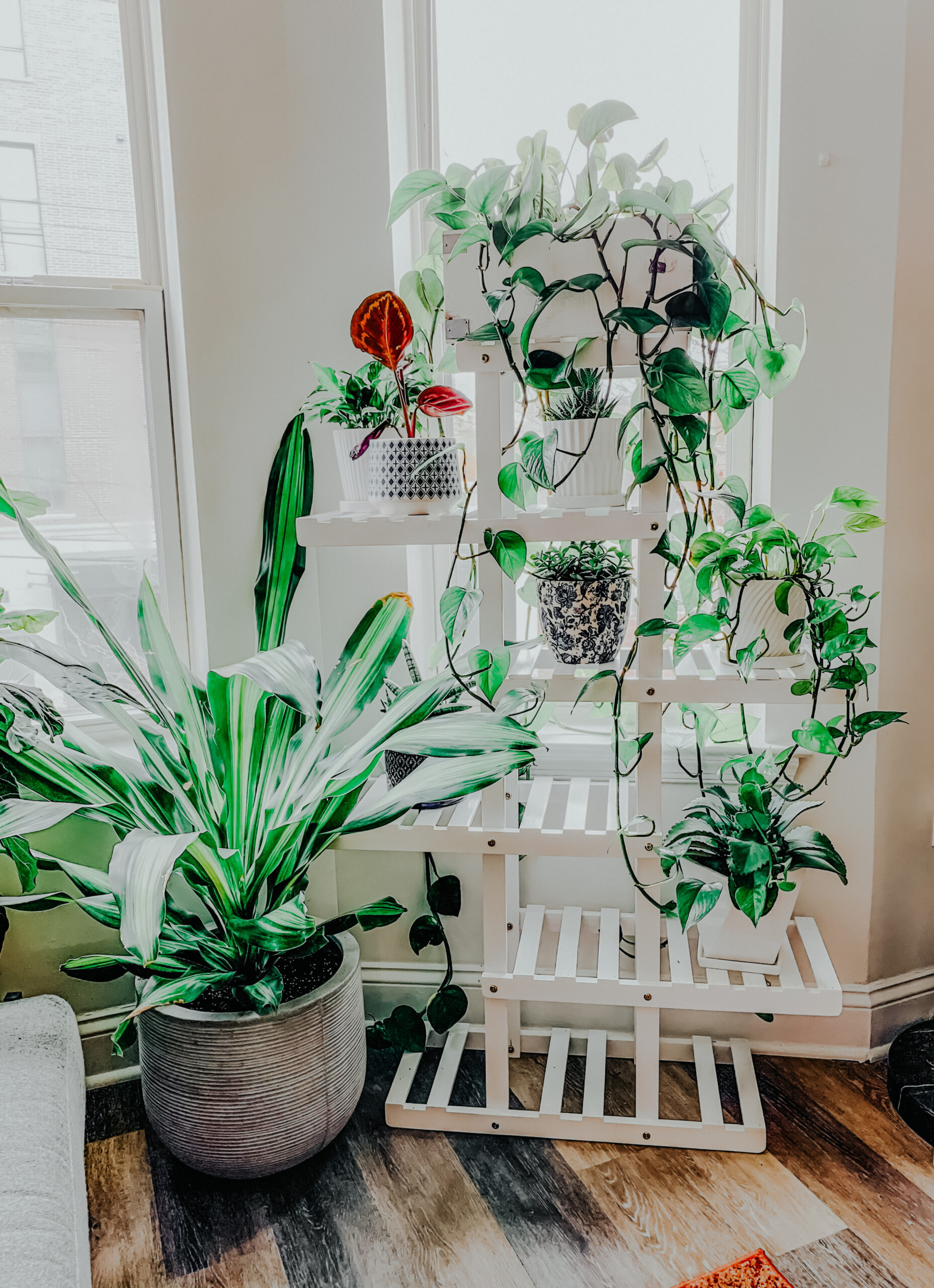 [clockwise] ‘Lemon Lime’ Dracaena, ‘Starfish Sansevieria’ Snake Plant, Calathea Medallion, Peace Lily, ‘Lace Aloe’ Aristaloe Aristata, Jade Plant, ‘Golden’ Pothos, ‘Mother of Thousands’ Kalanchoe Daigremontiana
[clockwise] ‘Lemon Lime’ Dracaena, ‘Starfish Sansevieria’ Snake Plant, Calathea Medallion, Peace Lily, ‘Lace Aloe’ Aristaloe Aristata, Jade Plant, ‘Golden’ Pothos, ‘Mother of Thousands’ Kalanchoe Daigremontiana
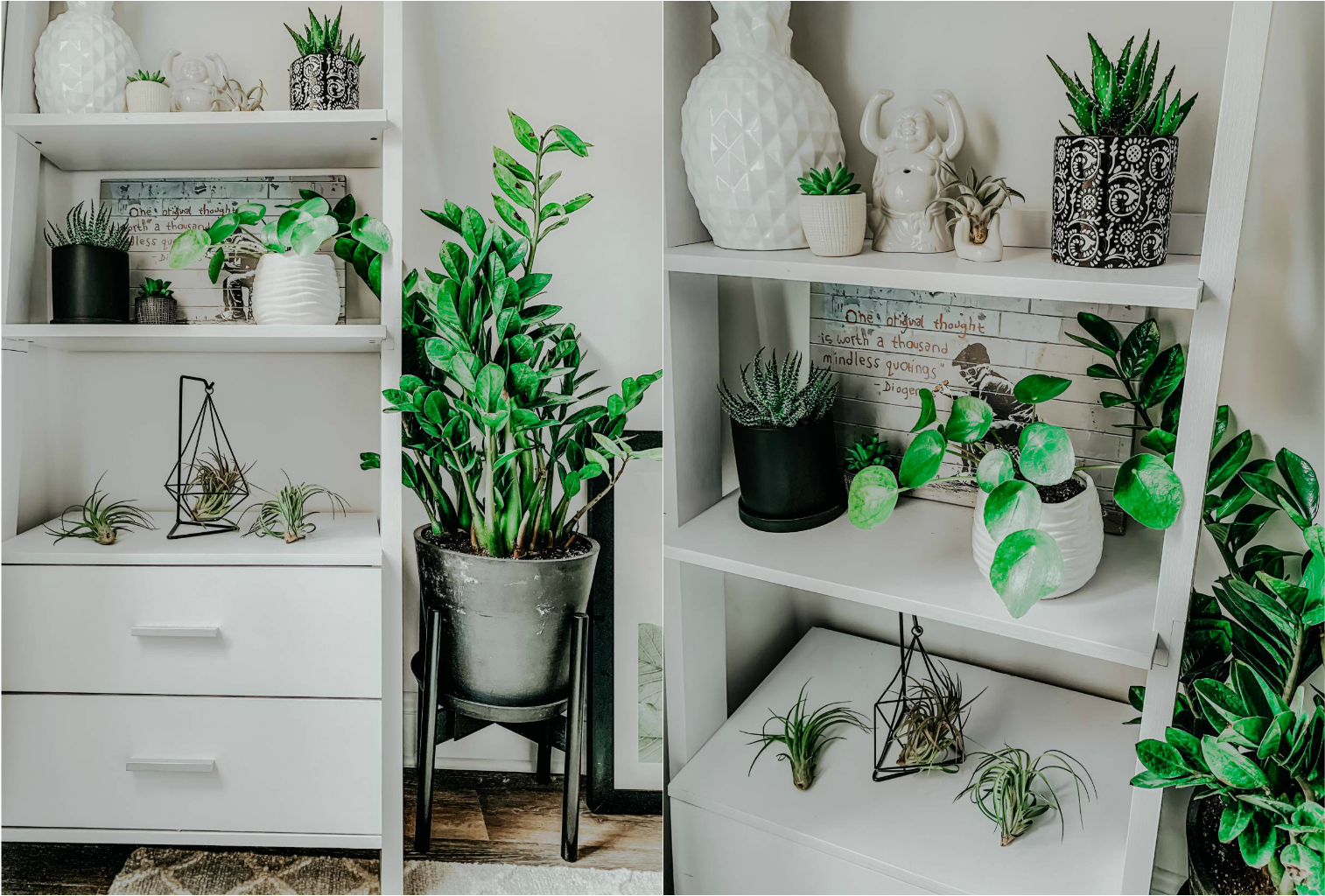 [L-R/T-B] ZZ Plant, ‘Doris Taylor’ Echeveria, ‘Mitre Aloe’ Perfoliata, ‘Tiger Tooth’ Aloe Aloe Juvenna, Haworthia Mutica, ‘Chinese Money’ Pilea Peperomioides, Air Plants
[L-R/T-B] ZZ Plant, ‘Doris Taylor’ Echeveria, ‘Mitre Aloe’ Perfoliata, ‘Tiger Tooth’ Aloe Aloe Juvenna, Haworthia Mutica, ‘Chinese Money’ Pilea Peperomioides, Air Plants
BONUS: POTS, STANDING PLANTERS & MORE THAT I’VE PURCHASED
Honestly TG for Amazon because I’ve been so fortunate to get so many of my plant care items at a moment’s notice from there. I’ve really lucked out with most of my purchases over the last 1.5 years of expanding my plant knowledge. Scroll the slider to shop some of the things I’ve gotten & been truly satisfied with:
—
—
Small Business Shops with Cute Pots/Planters
The Concrete Letter – handmade concrete decor
Props & Pop – modern pop culture + home decor
Falcon & Finch – incredibly creative air plant displays
EcoDeer – modern hanging wall planters + vases
Macrame Beautiful – gorgeous handmade macrame hanging planters
Living Arrangement – known for its DIY terrarium kits
Welds & Wood Co – amazing variety of sleek, modern plant stands
HousePlantopia – obsessed with their propagation stations


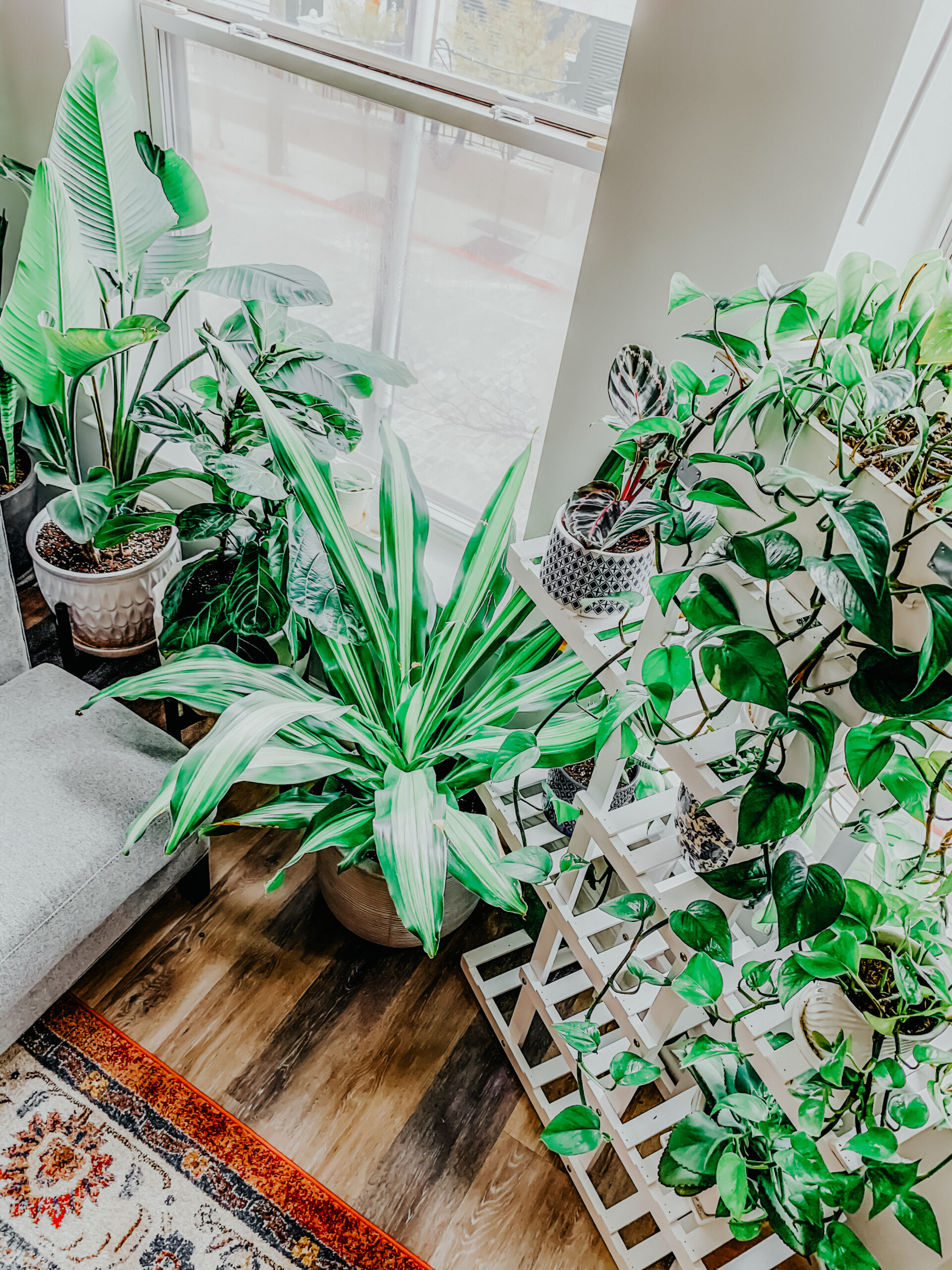
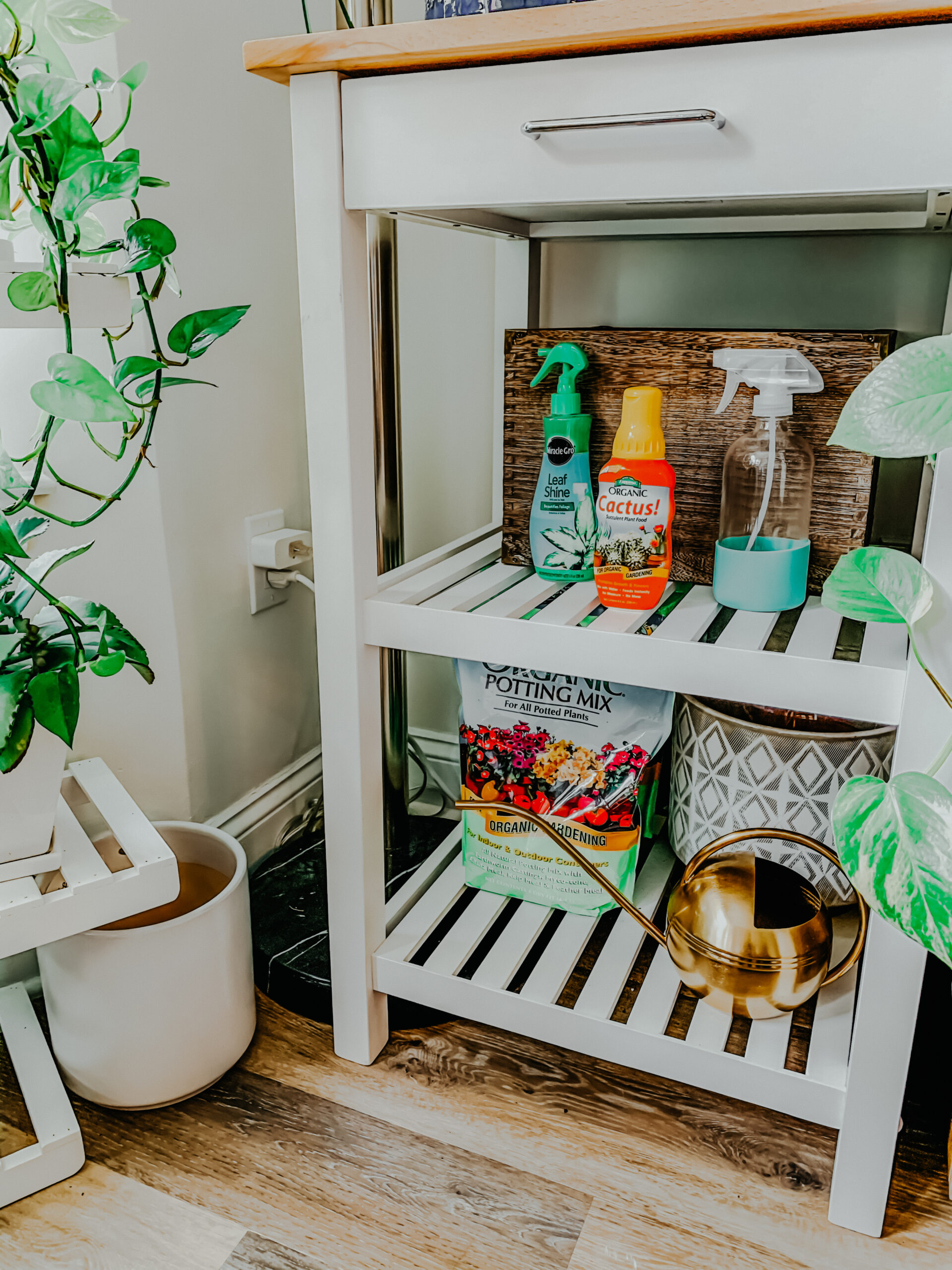
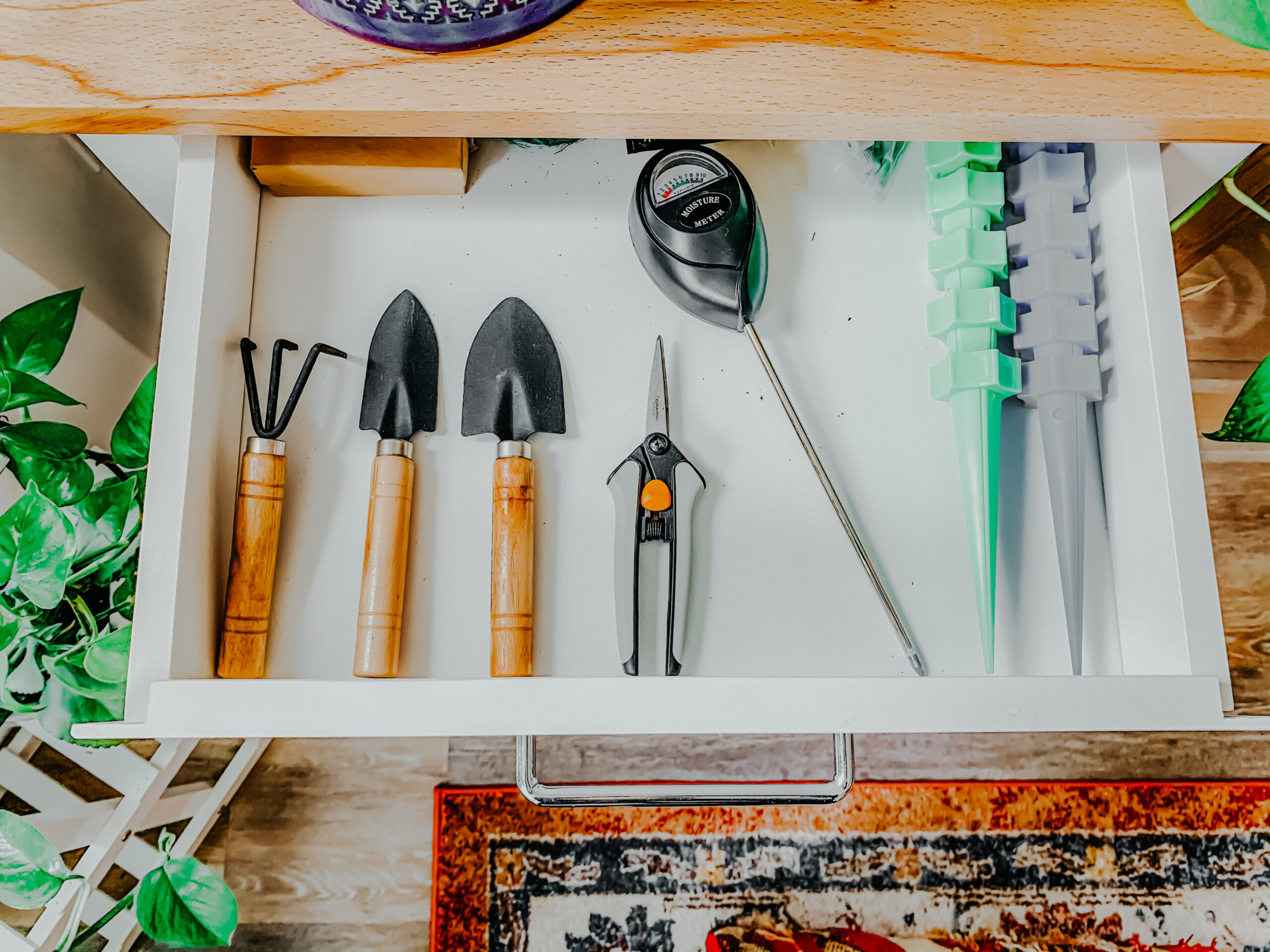

Your plants look great! I love having a lot of plants in my house but I really struggle to keep them alive…
♡ Kristina
TheKontemporary
Hopefully this post helps ya out babe! Anyone can be a plant parent for sure 😀 xx
These plants are gorgeous and the pictures are beautiful, I’d frame a picture of your plants. Hope you have a great weekend! Your post is so cheerful it put me in a good mood. xo~Sherry
Thank you so much Sherry!! So sweet of you xx
Love this! I have bought a few plants here recently and I needed this 💕
XOXO
Ahh so happy to hear this helped you, Brigite!! xx
Love plants and I’m new to the plant game lol. Thanks for the advice!
Yay!! Welcome to plant parenthood babe! xx
Loved your article. I love plants as well, so I definitely appreciate all the tips on taking care of them!
Wow I am bookmarking this post! You are so knowledgable and thanks for all this info. I do not have a green thumb but also want to add plants to my home. Thank you for sharing all these tips!
xoxo,
Christine
https://dailykongfidence.com/
Thank you so much Christine!! So glad you’re planning to add some plants to your home! They truly make it so enjoyable and relaxing, which is so important right now. I’m so excited for your new journey! xx
Great article! I love plants and have them all over my house 🙂 Thanks so much for sharing!
Thank you Katie!! Plants make a happy home, the more the merrier right!? xx